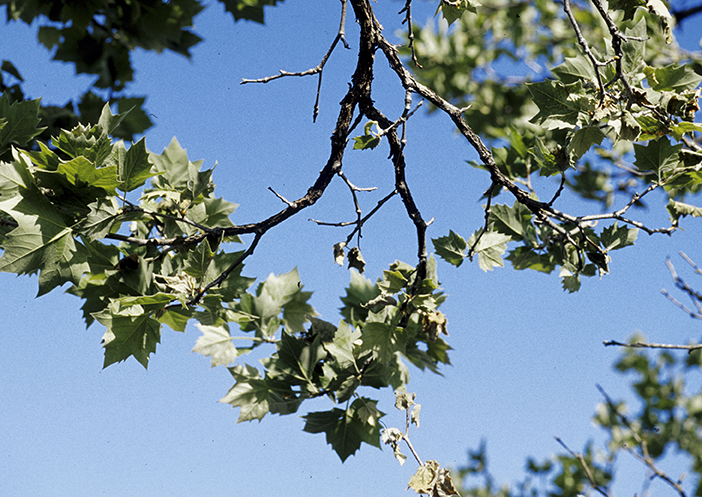Article provided courtesy of International Society of Arboriculture. Cover photo image citation: Joseph O’Brien, USDA Forest Service, Bugwood.org.
The term “anthracnose ” is used for a disease that affects a variety of shade trees. The species of fungus that results in anthracnose in plane trees is Apiognomonia veneta. Of the various types of plane trees, the American sycamore (Platanus occidentalis) is the most susceptible to the disease, with the oriental plane (P. orientalis) being much more resistant. The London plane, existing as a number of different clones (e.g., P. x hispanica), varies in susceptibility.
Signs of anthracnose in these trees include:
- Shoot blight: Young leaves and shoots may die back in spring, making the tree look as though it has suffered from frost damage.
- Bud blight: Buds may fail to open at all, sometimes on entire twigs or branches.
- Leaf blight: Leaves develop patches of dead tissue, most characteristically surrounding some of the main leaf veins.
- Twig blight: Affected leaves frequently fall prematurely, often while they are still predominantly green. Severely affected trees can shed the majority of their leaves by early summer. Twigs may be killed, and cankers may develop on larger branches.
Even severely affected trees usually recover to produce new growth by mid-summer. However, the overall vigor of the tree can be reduced, and branch growth may become distorted if frequent dieback occurs.
The fungus actively colonizes buds and twigs when the plant is dormant and susceptible during mild weather in autumn, winter and early spring. Twig dieback occurs when a canker enlarges and girdles the twig. Trees with significant bud and twig mortality produce thin crowns through late spring. In early spring, spores are produced on dead one-year-old twigs that infect expanding shoots and leaves. Infected shoots suddenly wilt and appear scorched, commonly following spring rains. Leaf blight of newly developed leaves also occurs, especially on the lower branches. Infected leaves develop tan to reddish-brown lesions that typically appear in the center of the leaf and extend along the leaf’s veins.

To help control anthracnose non-chemically, sweep up and burn fallen leaves, if practical. On young, small trees, it may be possible to prune out affected twigs or branches. Wet leaf surfaces promote establishment of this disease — improve air circulation and sunlight penetration by thinning crowded stands and pruning to thin the canopy. Maintain health of trees by providing adequate water and fertilizer. Healthy trees are more likely to recover from anthracnose infection than stressed trees.
Chemical sprays to control anthracnose are rarely justified, except when the disease occurs in stressed or recently transplanted trees, or when the disease causes repeated defoliations. Fungicide applications to prevent infections in the spring are sometimes warranted. If fungicide is required, use a labeled material containing thiophanate-methyl, chlorothalonil or mancozeb in spring. Fungicide injections are also used in spring and fall to systemically control the disease.

